
Stem Cells |

Sperm and Egg |
So I’m mulling the news that scientists hope to harvest stem cells from testicles. Beyond the way this new development makes me squeak with fear and cross my legs protectively, it’s also muddling my mind with cognitive dissonance trying to understand why harvesting stem cells from someone’s yarbles is considered significantly less controversial than embryonic stem cells.
President Bush Jr. has explained his stance on restricting stem cell research, because the blastocyst has the “potential for life.”
Bush isn’t a vegetarian, so we may assume he means human life, but the potential for human life is problematic. Sperm and unfertilized eggs both have the potential for human life, but the pro-life lobbists aren’t calling for an end to male masturbation or menstration, both of which terminate zygotes, reproductive cells. So it’s not the potential for life at all that serves as the criteria for restricting stem cell research for its opponents.
That leaves us with human life, established human life, a living human being. Everyone on all sides of this debate agrees that killing human beings is wrong. No argument there. So now we have to figure out the criteria for what makes a living human being.
Pro-Life proponents believe a living human being begins at fertilization:
When humans procreate, they don’t make non-humans like slugs, monkeys, cactuses, bacteria, or any such thing. Emperically-verifiable [sic] proof is as close as your nearest abortion clinic: send a sample of an aborted fetus to a laboratory and have them test the DNA to see if its human or not. Genetically, a new human being comes into existence from the earliest moment of conception.
So the 23 chromosomes in the sperm recombinate with the 23 chromosomes of the egg, and at the moment there are 46 chromosomes in a single cell, according to this definition, we have an established living human being. “Period. No debate.”
Every cell in our bodies, with the exception of our zygotes, has 46 chromosomes of our human DNA; therefore, according to both the “complete set of chromosomes” and “potential for life” criteria, a skin graft is an established living human being. Period. No debate.
But we don’t see Pro-Life proponents picketing hospital Burn Units, and shooting plastic surgeons, so, to give them the benefit of the doubt, their definition of established human life goes beyond both these criteria. They must mean only those cells that make up a blastocyst, stem cells.
Again, this is lacking. Not all of the cells in the fertilized zygote are what we would normally consider human. The blastocyst’s outer cells will become the placenta, the remarkable organ that supports and nourishes the fetus by robbing the mother of these necessities. Although technically not a parasite, evolution has struck a long-fought balance between the needs of the mother and fetus, in some respects, pregnancy is a battle between the two.
Once again, we don’t see Pro-Life proponents conducting rescue missions to save unwanted placentas. So, although they are referring to the whole blastocyst when preventing stem cell research, because removing any part of it would remove the potential for human life, they don’t really consider the whole thing a human life.
Medical science defines pregnancy, not necessarily human life, as beginning at conception, the point at which the fertilized zygote attaches to the uterus. This does not always happen, and in fact accounts for three-fourths of lost pregnancies.
Again, the inconsistencies of Pro-Life definitions intrude on rational thought. They have set up organizations for couples to adopt the surplus embryos produced through in vitro fertilization (IVF), which they call “Snowflake Children;” however, Pro-Life proponents are unconcerned with embryos produced naturally that fail to attach to the uterine wall and are rejected by the woman’s body through spontaneous abortion. 20% of known pregnancies end in miscarriage, but it is believed this number would be much higher were it possible to include unknown pregnancies. By one estimate five out of six fertilized zygotes never implant (from the BBC’s Intimate Universe, 1998).
Confused about when life begins? I am, and we should be. The biology of human reproduction is an incredibly complex process, and the evangelical movement’s delusive actions, which feign their attentions as being solely on abortion, but their actions belie pathological struggle to control human sexuality.
Unfortunately, this is where the debate ends. For while scientifically-minded people are having an honest and open debate about when human life really begins, Pro-Life proponents reject such an exchange of ideas. Their position is set in stone, and the challenges I have posited here and the challenges other developments have brought up, from Hoo Suk Hwang’s successful creation of parthenogenesis in a human, where the disgraced doctor got a human egg to self-fertilize, to Twin-to-twin transfusion syndrome, where the termination of one fetus may be necessary to prevent the loss of another.
There is a perpetual debate refining our understanding of these intricacies in human reproduction, and it’s time the Pro-Life movement came to the table and engaged them with us.
As noted by ichthyes in the comments, I was lazy and sloppy with some of my terminology in this post:
a zygote is the result of fusion between two gametes, gametes (not zygotes) being the sex cells that carry 23 chromosomes in humans. There are other things, but nevermind.
Peer-reviews/corrections are always welcomed.
Comments
5 responses to “Is It Life Yet?”